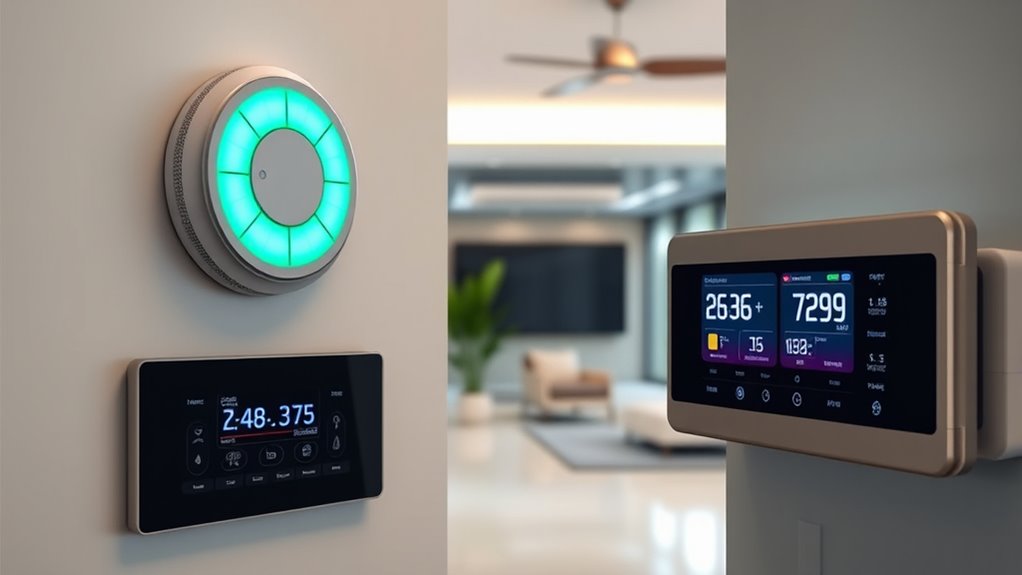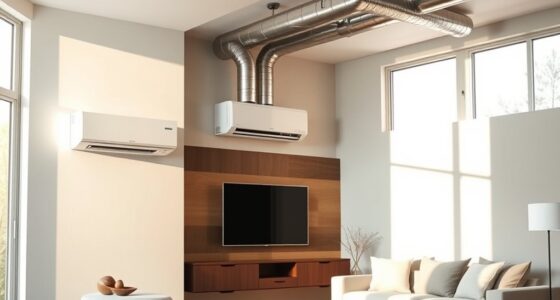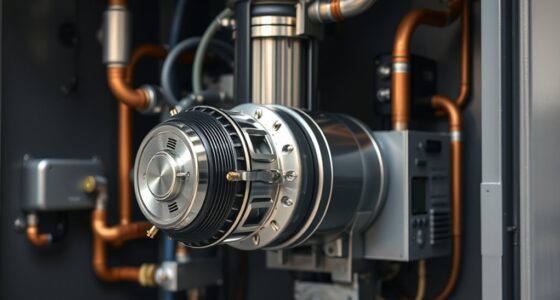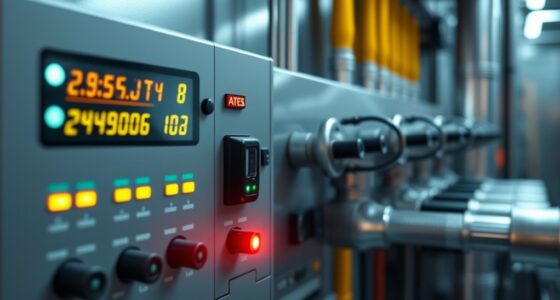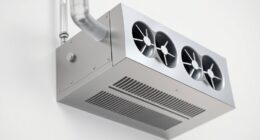Indoor air quality sensors can seamlessly connect with your HVAC system to provide continuous monitoring of pollutants, humidity, and temperature. This integration enables automated adjustments like increasing ventilation or activating air purifiers when air quality drops. It helps you stay compliant with health standards while reducing energy costs through smarter control. With real-time data and alerts, you can maintain a healthier indoor environment effortlessly. Keep exploring to discover how this technology can transform your space.
Key Takeaways
- Indoor air quality sensors provide real-time data to optimize HVAC system responses for healthier environments.
- Integration enables automated adjustments of ventilation and filtration based on pollutant levels.
- Sensors help ensure compliance with air quality standards, supporting regulatory requirements.
- Combining IAQ sensors with HVAC systems enhances energy efficiency and reduces operational costs.
- Continuous monitoring simplifies maintenance, troubleshooting, and promotes healthier indoor air quality.
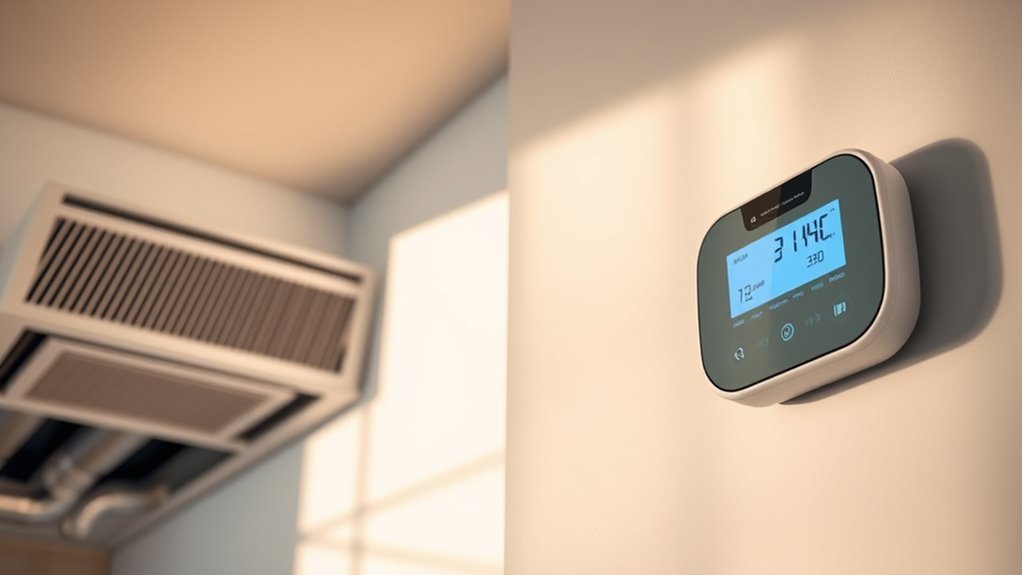
Indoor air quality (IAQ) sensors are transforming how we manage indoor environments by providing real-time data on pollutants, humidity, and temperature. These sensors enable you to monitor the air you breathe constantly, making it easier to maintain a healthy and comfortable space. By integrating IAQ sensors with your HVAC system, you can automate responses to changing air conditions, ensuring that air quality stays within recommended standards. One of the key benefits of this integration is adhering to air quality standards set by health authorities and industry regulations. These standards specify acceptable levels of pollutants like volatile organic compounds (VOCs), particulate matter, and carbon dioxide, which directly impact occupant health and comfort. When IAQ sensors detect levels exceeding these thresholds, your HVAC system can automatically adjust ventilation rates or activate air purification systems to restore ideal conditions. This proactive approach minimizes health risks and reduces energy waste by preventing unnecessary system operation. Ventilation control becomes more precise and responsive, allowing you to manage airflow based on real-time data rather than fixed schedules or manual adjustments. For instance, if sensors detect a spike in indoor pollutants, your system can increase outdoor air intake or activate filtration units immediately. Conversely, during periods of clean air, the system can reduce ventilation to conserve energy. This dynamic control not only improves indoor air quality but also enhances energy efficiency and operational cost savings. Furthermore, integrating IAQ sensors with HVAC systems helps ensure compliance with increasingly stringent air quality regulations, which are becoming more prevalent in commercial and residential buildings. By continuously monitoring indoor conditions, you can demonstrate adherence to standards, avoid potential penalties, and promote healthier environments for occupants. Incorporating advanced sensor technology, such as real-time monitoring and precise data collection, further optimizes system performance and responsiveness. The technology also offers peace of mind, as you receive alerts when air quality drops below safe levels, allowing prompt action. The seamless communication between sensors and HVAC controls simplifies maintenance and troubleshooting, as you get detailed insights into indoor air conditions and system performance. In conclusion, IAQ sensors combined with advanced ventilation control empower you to create safer, healthier indoor spaces. They help maintain air quality within regulatory standards, fine-tune ventilation based on real-time data, and improve overall system efficiency. This integration doesn’t just enhance comfort; it also supports regulatory compliance and promotes sustainable building management practices. As indoor environments become more complex and health concerns more prominent, leveraging IAQ sensors in your HVAC system ensures you stay ahead in providing safe, high-quality air for everyone inside.
Frequently Asked Questions
How Do Indoor Air Quality Sensors Impact Energy Efficiency?
Indoor air quality sensors boost energy efficiency by enabling ventilation optimization, so your HVAC system adjusts airflow based on real-time air quality data. This prevents unnecessary ventilation, reducing energy consumption while maintaining a healthy environment. As you rely on these sensors, you’re effectively balancing fresh air intake with energy use. Ultimately, they help you save on costs and guarantee ideal indoor air quality without overworking your HVAC system.
What Maintenance Do Indoor Air Quality Sensors Require?
You need to regularly clean dust accumulation on your indoor air quality sensors to guarantee accurate readings. Additionally, sensor calibration is essential; check and recalibrate the sensors as recommended by the manufacturer, typically once a year. Proper maintenance helps prevent false data, improves system performance, and extends the lifespan of your sensors. By staying on top of these tasks, you’ll keep your indoor air quality monitoring reliable and effective.
Can Sensors Detect Specific Indoor Pollutants Accurately?
In a flash, sensors can detect specific indoor pollutants with reasonable accuracy, but their effectiveness depends on proper sensor calibration. While some sensors are designed for pollutant specificity, others might only give a general air quality reading. To guarantee precise detection, regular calibration is essential, especially if you want to identify particular pollutants like VOCs or particulate matter. This way, you get reliable data to improve your indoor environment.
Are There Wireless Options for Integrating Sensors With HVAC Systems?
Yes, wireless options exist for integrating sensors with HVAC systems. You can use sensors with wireless connectivity, allowing seamless communication without extensive wiring. Just guarantee proper sensor calibration for accurate readings and reliable system performance. These wireless sensors can easily connect to your HVAC controls, providing real-time air quality data and enabling automatic adjustments to maintain ideal indoor conditions. This setup enhances convenience and system efficiency.
How Quickly Do Sensors Respond to Changes in Air Quality?
Ever wonder how fast sensors detect air quality changes? Typically, sensor response time ranges from a few seconds to a minute, depending on calibration and technology. Proper sensor calibration ensures quick, accurate readings, so you get timely alerts and adjustments. If your sensor isn’t responding swiftly, it might need recalibration or replacement. Wouldn’t you prefer your system reacts instantly to maintain ideal air quality?
Conclusion
By integrating indoor air quality sensors with HVAC systems, you’re creating a gust of clean air in your space. Think of it as giving your environment a vigilant guardian that constantly adjusts to keep air clean and healthy. This smart partnership not only boosts comfort but also makes your space feel like a sanctuary. Embrace this technology, and you’ll turn your home into a fortress of pure, fresh air—your lungs will thank you for it.
